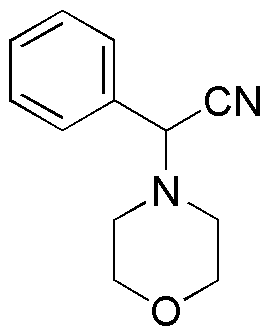a-(4-Morpholino)Phenylacetonitrile is widely utilized in research focused on
- Pharmaceutical Development: This compound serves as an important intermediate in the synthesis of various pharmaceuticals, particularly in the development of drugs targeting neurological disorders.
- Chemical Synthesis: It is used in organic synthesis as a building block for creating more complex chemical structures, which is essential in both academic and industrial research settings.
- Biological Research: Researchers employ this compound to study its effects on cellular processes, helping to uncover potential therapeutic pathways for diseases.
- Material Science: It finds applications in the development of specialty materials, such as polymers and coatings, due to its unique chemical properties.
- Analytical Chemistry: This compound is utilized in various analytical techniques, aiding in the detection and quantification of other substances in complex mixtures.
General Information
Properties
Safety and Regulations
Applications
a-(4-Morpholino)Phenylacetonitrile is widely utilized in research focused on
- Pharmaceutical Development: This compound serves as an important intermediate in the synthesis of various pharmaceuticals, particularly in the development of drugs targeting neurological disorders.
- Chemical Synthesis: It is used in organic synthesis as a building block for creating more complex chemical structures, which is essential in both academic and industrial research settings.
- Biological Research: Researchers employ this compound to study its effects on cellular processes, helping to uncover potential therapeutic pathways for diseases.
- Material Science: It finds applications in the development of specialty materials, such as polymers and coatings, due to its unique chemical properties.
- Analytical Chemistry: This compound is utilized in various analytical techniques, aiding in the detection and quantification of other substances in complex mixtures.
Documents
Safety Data Sheets (SDS)
The SDS provides comprehensive safety information on handling, storage, and disposal of the product.
Product Specification (PS)
The PS provides a comprehensive breakdown of the product’s properties, including chemical composition, physical state, purity, and storage requirements. It also details acceptable quality ranges and the product's intended applications.
Certificates of Analysis (COA)
Search for Certificates of Analysis (COA) by entering the products Lot Number. Lot and Batch Numbers can be found on a product’s label following the words ‘Lot’ or ‘Batch’.
Numéro de catalogue
Numéro de lot/série
Certificates Of Origin (COO)
This COO confirms the country where the product was manufactured, and also details the materials and components used in it and whether it is derived from natural, synthetic, or other specific sources. This certificate may be required for customs, trade, and regulatory compliance.
Numéro de catalogue
Numéro de lot/série
Safety Data Sheets (SDS)
The SDS provides comprehensive safety information on handling, storage, and disposal of the product.
DownloadProduct Specification (PS)
The PS provides a comprehensive breakdown of the product’s properties, including chemical composition, physical state, purity, and storage requirements. It also details acceptable quality ranges and the product's intended applications.
DownloadCertificates of Analysis (COA)
Search for Certificates of Analysis (COA) by entering the products Lot Number. Lot and Batch Numbers can be found on a product’s label following the words ‘Lot’ or ‘Batch’.
Numéro de catalogue
Numéro de lot/série
Certificates Of Origin (COO)
This COO confirms the country where the product was manufactured, and also details the materials and components used in it and whether it is derived from natural, synthetic, or other specific sources. This certificate may be required for customs, trade, and regulatory compliance.


